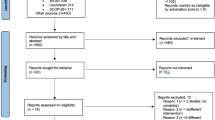Abstract
Data sources
PubMed, Web of Science and Cochrane Oral Health Group Trials. Register databases supplemented by hand searching a range of dental implants-related journals.
Study selection
Randomised and non-randomised studies comparing implant failure rates in any group of patients receiving dental implants being inserted in fresh extraction sockets compared to the insertion in healed sites were considered.
Data extraction and synthesis
Study quality was assessed using the Newcastle-Ottawa scale (NOS). Implant failure (complete loss of implant) and postoperative infection were the dichotomous outcomes measures evaluated, with marginal bone loss as a continuous outcome.
Results
Seventy-three publications were included, five were randomised controlled trials, 26 clinical controlled trials and 42 retrospective studies. The 73 studies included a total of 8241 dental implants inserted in fresh extraction sockets, with 330 failures (4.00%), and 19,410 implants inserted in healed sites, with 599 failures. A random effects meta-analysis (73 studies) found the relative risk of implant failures in fresh socket sites compared to healed sites was RR= 1.58 (95% CI; 1.27 1.95) for the maxilla only RR= 1.61 (95% CI; 0.97 2.66); mandible only RR= 2.15 (95% CI; 0.62-7.47). For implants supporting single crown restoration RR= 2.05 (95% CI; 1.36-3.11) and RR= 1.42 (95% CI; 0.71- 2.83) for those with a full arch prosthesis.
There were 31 controlled studies (CCTs) and randomised controlled studies (RCTs) that included 2021 implants inserted in fresh sockets with 96 failures (4.75%) and 2759 implants were inserted in healed sites with 49 failures (1.59%). The relative risk of implant failures in fresh socket sites compared to healed sites was RR= 2.27 (95% CI; 1.57-3.29).
Conclusions
The results of the present review should be interpreted with caution due to the presence of uncontrolled confounding factors in the included studies, most of them not randomised trials. Within the limitations of the existing investigations, the present study suggests that the insertion of dental implants in fresh extraction sockets affects the implant failure rates.
Similar content being viewed by others
Commentary
Endosseous implants normally offer a valid therapeutic option to replace lost teeth. Traditionally, implants were placed several months following tooth extraction to allow alveolar bone healing.1 However, tooth replacement with implant placed into a fresh extraction socket has become a routine procedure that may offer advantages for both the patient and clinician. The main advantages of insertion of dental implants immediately after extractions are shorter treatment time, less morbidity and reduced overall cost.2 However, some disadvantages have also been reported such as postoperative complications.3
While some previous reviews showed similar survival rates of implants placed in fresh extraction sockets when compared to implants placed in mature bone, (conventional placement),3,4 some others showed higher failure rates.5 Even though there is a considerable number of studies comparing these techniques, clinical data on the outcomes are still controversial.
The predictability of dental implants placed in fresh extraction sockets compared to the placement in healed sockets has been assessed in a recent systematic review and meta-analysis.6 Outcomes measures were implant failure rates, postoperative infection and marginal bone loss. It was conducted with no restrictions on date of publications. Electronic and hand searching with critical appraisal was performed. Controlled clinical trials, randomised controlled trials (RCT) and retrospective analysis were mainly included in this review; however, most of them were not randomised. The reason given to review non-randomised studies was to include the results of more trials and thus of more significant data, due to a limited number of RCTs.
The authors used the Newcastle-Ottawa scale of nine points to critically appraise the quality of non-randomised studies incorporating the quality assessments in the interpretation of meta-analytic results. The authors' grading for the risk of selection bias was high quality for all studies except three.
Even though the results were analysed including all the studies or controlled studies only, a statistically significant difference in implant failures was found. However, no significant difference was found on marginal bone loss or the occurrence of postoperative infection.
The authors recommended that the results included in this review and meta-analysis have to be interpreted with caution, mostly due to potential biases from the non-randomised studies that are likely to be greater compared with randomised studies. For that reason, larger, long-term, well-designed controlled randomised clinical trials are needed.
A Cochrane systematic review was published in 20107 to examine the effect of timing of implant placement after tooth extraction. That review identified seven randomised clinical trials fulfilling the selecting criteria. It was considered that the evidence was' insufficient evidence to determine possible advantages or disadvantages of immediate, immediate-delayed or delayed implants', but it was suggested that immediate implants may be at a higher risk of implant failure and complications than implants placed in healed sites.
However, they found no statistically significant differences in implant survival and clinical outcomes. The authors stated that aesthetic outcomes may be better when placing implants in fresh sockets just after tooth extraction. The conclusions of this review confirmed what the Cochrane review had suggested prior, with regard to immediate implants.
Several clinical parameters: case selection, surgical and prosthetic technique and clinical experience must be taken into consideration if implants placed in fresh sockets are to succeed. Therefore, clinicians may treat suitable patients with immediate implants as a viable alternative to delayed implant placements.
References
Branemark PI . Introduction to osseointegration. In: Branemark PI, Zarb G, Albrektsson T, (eds) Tissue-integrated prostheses. Osseointegration in clinical dentistry. pp 11–76. Chicago, Berlin: Quintessence Publishing Co 1985.
Barzilay I . Immediate implants: their current status. Int J Prosthodont 1993; 6: 169–175.
Chen ST, Buser D . Clinical and esthetic outcomes of implants placed in postextraction sites. Int J Oral Maxillofac Implants 2009; 24: 186–217.
Quirynen M, Van Assche N, Botticelli D, Berglundh T . How does the timing of implant placement to extraction affect outcome? Int J Oral Maxillofac Implants 2007; 22: 203–223.
Schropp L, Isidor F . Timing of implant placement relative to tooth extraction. J Oral Rehabil 2008; 35: 33–43.
Chrcanovic BR, Albrektsson T, Wennerberg A . Dental implants inserted in fresh extraction sockets versus healed sites: a systematic review and meta-analysis. J Dent 2015; 43: 16–41.
Esposito M, Grusovin MG, Polyzos IP, Felice P, Worthington HV . Interventions for replacing missing teeth: dental implants in fresh extraction sockets (immediate, immediate-delayed and delayed implants). Cochrane Database Syst Rev 2010 8; (9):CD005968.
Author information
Authors and Affiliations
Additional information
Address for correspondence: Bruno Ramos Chrcanovic, Department of Prosthodontics, Faculty of Odontology, Malmö University, Carl Gustafs väg 34, SE-205 06, Malmö, Sweden. E-mail: bruno.chrcanovic@mah.se; brunochrcanovic@hotmail.com
Chrcanovic BR, Albrektsson T, Wennerberg A. Dental implants inserted in fresh extraction sockets versus healed sites: a systematic review and meta-analysis. J Dent 2015; 43: 16–41.
Rights and permissions
About this article
Cite this article
Khouly, I., Keenan, A. Review suggests higher failure rates for dental implants placed in fresh extraction sites. Evid Based Dent 16, 54–55 (2015). https://doi.org/10.1038/sj.ebd.6401098
Published:
Issue Date:
DOI: https://doi.org/10.1038/sj.ebd.6401098



